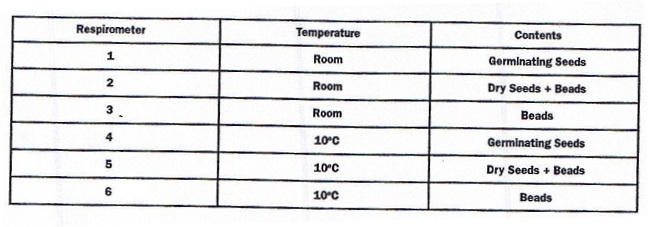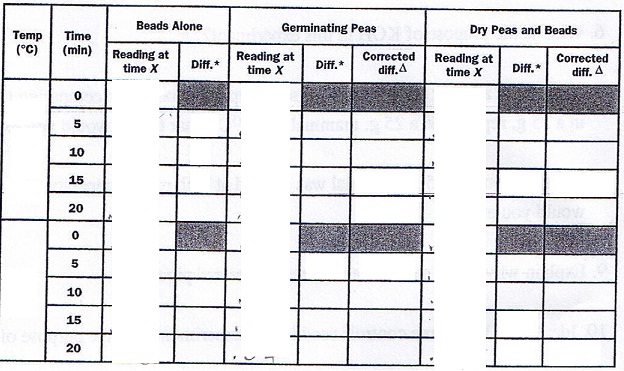Assignment:
OVERVIEW
In this experiment you will work with seeds that are living but dormant. A seed contains an embryo plant and a food supplysurrounded by a seed coat. When the necessary conditions are met, germination occurs and the rate of cellular respirationgreatly increases. In this lab you will:
1. Measure oxygen consumption during germination,
2. Measure the change in gas volume in respirometers containing either germinating or nongerminating pea seeds, and
3. Measure the rate of respiration of these peas at two different temperatures.
OBJECTIVES
- Before doing this lab you should understand:
- Respiration, dormancy, and germination;
- How a respirometer works in terms of the gas laws;
- The general processes of metabolism in living organisms; and
- How the rate of cellular respiration relates to the amount of activity in a cell. After doing this lab you should be able to:
- Calculate the rate of cell respiration from experimental data;
- Relate gas production to respiration rate;
- Test the rate of cellular respiration in germinating versus nongenninated seeds in a controlled experiment; and
- Test the effect of temperature on the rate of cell respiration in germinating versus nongerminated seeds in a controlled experiment.
INTRODUCTION
Aerobic cellular respiration is the release of energy from organic compounds by metabolic chemical oxidation in the mitochondriawithin each cell. Cellular respiration involves a series or enzyme-mediated reactions.
The equation below shows the complete oxidation of glucose. Oxygen is required for this energy-releasing process to occur.
CH12O6 + 6O2 -> 6 CO2 + 6 H2O + 686 kilocalories of energy/mole of glucose oxidized.
By studying the equation above, you will notice there are three ways cellular respiration could be measured. One could measure the
Part-1
1. Consumption of O2 (flow many moles of O2 are consumed in cellular respiration?)
2. Production of CO2 (How many moles of CO2 are produced in cellular respiration?)
3. Release of energy during cellular respiration
In this experiment the relative volume of O2 consumed by germinating and nongerminating (dry) peas at two different temperatures will be measured.
Background Information
A number of physical laws relating to gases are important to the understanding of how the apparatus that you will use in this exercise works. The laws are summarized in the general gas law that states:
PV=nRT
Where P is the pressure of the gas,
V is the volume of the gas,
N is the number of molecules of gas,
R is the gas constant (its value is fixed), and
T is the temperature of the gas (in °K).
This law implies the following important concepts about gases:
Part-2
1. If the temperature and pressure are kept constant, then the volume of the gas is directly proportional to the number of molecules of the gas.
2. If the temperature and volume remain constant, then the pressure of the gas changes in direct proportion to the number of molecules of gas present
3. If the number of gas molecules and the temperature remain constant, then the pressure is inversely proportional to the volume.
4. If the temperature changes and the number of gas molecules are kept constant, then either the pressure or volume (or both) will change in direct proportion to the temperature.
It is also important to remember that gases and fluids flow from regions of high pressure to regions of low pressure.
In this experiment the CO2 produced during cellular respiration will be removed by potassium hydroxide (KOH) and will form solid potassium carbonate (K2CO3) according to the following reaction:
CO2 + 2KOH -> K2CO3 + H2O
Since the CO2 is being removed, the change in the volume of gas in the respirometer will be directly related to the amount of oxygen consumed.
In the experimental apparatus shown in Figures 5.1 and 5.2, if water temperature and volume remain constant, the water will move toward the region of lower pressure. During respiration, oxygen will be consumed. Its volume will be reduced, because the CO2 produced is being converted to a solid. The net result is a decrease in gas volume within the tube and a related decrease in pressure in the tube. The vial with glass beads alone will permit detection of any changes in volume due to atmospheric pressure changes or temperature changes.
The amount of O2 consumed will be measured over a period of time. Six respirometers should be set up as follows:

Part-3
1. Both a room temperate bath (by convention, 25°C) and a 10°C bath should be set up immediately to allow time for the temperature of each to adjust. Add ice to attain 10°C.
2. Respirometer 1: Obtain a 100-mL graduated cylinder and fill it with 50 mL of H2O. Drop 25 germinating peas in the graduated cylinder and determine the amount of water that was displaced (which is equivalent to the volume of the peas). Record the volume of the 25 germinating peas. Remove these peas and place them on a paper towel. They will be used in respirometer 1.
Pea Volume: 10 mL.
3. Respirometer 2: Refill the graduated cylinder with 50 mL of H2O. Drop 25 dried peas (not germinating) into the graduated cylinder and then add enough glass beads to attain a volume equivalent to that of the expanded germinating peas. Remove these peas and beads and place them on a paper towel. They will be used in respirometer 2.
4. Respirometer 3: Refill the graduated cylinder with 50 mL of l-1~O. Determine how many glass beads would be required to attain a volume equivalent to that of the germinating peas. Remove these beads and place them on a paper towel. They will be used in respirometer 3.
5. Repeat Steps 1-4 to prepare a second set of germinating peas, dry peas plus beads, and beads for use in respirometers 4, 5, and 6, respectively.
6. To assemble the six respirometers, obtain six vials, each with an attached stopper and pipette. Place a small piece of cotton in the bottom of each vial and, using a dropper, moisten the cotton with 15% KOH* Make sure that the respirometer vials are dry on the inside. Do not get KOH on the sides of the respirometer. Place a small wad of nonabsorbent cotton on top of the KOH soaked absorbent cotton (see Figure 5.1). It is important that the amounts of cotton and KOH be the same for each respirometer.
7. Place the first set of germinating peas, dry peas plus beads, and beads in vials 1, 2, and 3, respectively. Place the second set of germinating peas, dry peas plus beads, and beads in vials 4, 5, and 6, respectively. Insert the stopper fitted with the calibrated pipette. Place a weighted collar on each end of the vial (see Figure 5.2).
8. Make a sling of masking tape attached to each side of each of the water baths to hold the pipettes out of the water dining an equilibration period of seven minutes. Vials 1, 2, and 3 should rest in the room-temperature water bath (approximately 25°C) and vials 4, 5, and 6 should rest in the 10°C water bath (see Figure 5.2).
9. After the equilibration period of seven minutes, to the nearest all six respirometers entirely in their water baths. Water will enter the pipettes for a short distance and then stop. If the water continues to move into a pipette, check for leaks in the respirometer. Work swiftly and arrange the pipettes so that they can be read through the water at the beginning of the experiment. They should not be shifted during the experiment. Hands should be kept out of the water bath after the experiment has started. Make sure that a constant temperature is maintained.
10. Allow the respirometers to equilibrate for three more minutes and then record, to the nearest 0.01mL, the initial position of water in each pipette (time 0). Check the temperature in both baths and record it in Table 5.1. Every 5 minutes for 20 minutes, take readings of the water's position in each pipette and record the data in Table 5.1.
Table 5.1: Measurement of °~ Consumption by Soaked and Dry Pea Seeds at Room Temperature (25°C) and 10°C Using Volumetric Methods

GRAPH Graph the results from the corrected difference column for the germinating peas and dry peas at both room temperature and at 10°C. Place the time in minutes on the x-axis and ml O2 consumed on the y-axis. (Please Use Excel.)
DISCUSSION QUESTIONS
1. Describe the relationship between the amount of O2 consumed and time.
2. From the slope of the four lines on the graph, determine the rate of O2 consumption of germination and dry peas during the experiments at room temperature and at 10°C.
Room Temp. mL O2/min germinating peas
10°C mL O2/mingerminatingpeas
Room Temp. mL O2 /min dry peas
10°C mL O2/min dry peas
3. Why is it necessary to correct the pea readings with the bead readings?
4. What was the effect of germination versus nongerminalion on pea seed respiration?
5. What was the effect of temperature on pea seed respiration?
6. What is the purpose of KOH in this experiment?
7. If you used a larger apparatus in the same type of experiment comparing the rates of respiration in a 25 g. reptile and a 25 g. mammal, at 10°C, what results would you expect? Explain.
8. If respiration in a 25 g. mammal was studied at both room temperature and 10°C, what results would you expect? Explain.
9. Explain why water moved into the respirometers pipettes.
10. Identify at least three controls used in this experiment, and the purpose of each.